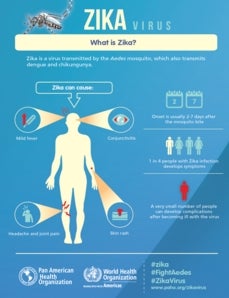
Image courtesy of PAHO
Yesterday, the World Health Organization announced that the Zika virus was “spreading explosively” in the Americas and that as many as three to four million people in the region could be infected in the next year. 23 countries and territories in the region have already reported cases of infection with the virus. Zika is transmitted by the Aedes mosquito, which also transmits dengue and Chikungunya viruses. One in four people with Zika infection develops symptoms, which can include mild fever, conjunctivitis, headache and joint pain, and skin rash.
Although Zika virus infection typically causes only mild symptoms, outbreaks in Brazil have coincided with a notable increase in microcephaly in newborns. Brazil has reported over 4,000 cases of microcephaly since October, compared to only about 150 cases each year before the epidemic. Microcephaly is an uncommon condition in which infants are born with abnormally small heads. It can present as an isolated condition or may be associated with other conditions, such as convulsions, developmental delays, or feeding difficulties, of varying degrees of severity. In many cases, microcephaly is life-threatening.
Various factors have made it particularly difficult to prevent the spread of the Zika virus and reduce its impact. Here are just a few:
- Further research is needed to confirm whether additional modes of Zika transmission exist. While the role of Aedes mosquitoes in transmitting Zika is documented and well-understood, evidence about other transmission routes is limited. According to the Centers for Disease Control and Prevention, although rare, a mother already infected with the virus near the time of delivery can pass it on to her newborn around the time of delivery. It is also possible that Zika could be passed from mother to fetus during pregnancy, through a blood transfusion, and through sexual contact, but additional research is needed to confirm whether these are in fact modes of Zika virus transmission.
- It will likely take years and cost tens or even hundreds of millions of dollars to develop a Zika virus vaccine. Currently, there is no vaccine against the Zika virus. Two of the world’s biggest vaccine companies – GlaxoSmithKline and Sanofi – are evaluating whether existing vaccine technology can be used to make a Zika virus vaccine. However, creating and testing a vaccine normally takes years and costs hundreds of millions of dollars and efforts do to so have only just begun.
- Current campaigns to delay pregnancy are shortsighted, failing to account for women who do not have access to contraceptives or become pregnant as a result of sexual violence. Many Zika virus-affected countries in the region are urging women to delay becoming pregnant for months or, in some cases, years. Colombia, which has the second highest Zika virus infection rate, after Brazil, is recommending that Colombians delay pregnancy for the next six to eight months. El Salvador’s government has gone further, advising all women in the country not to get pregnant for at least two years. Many Latin American women, however, are simply not able to delay pregnancy. According to Paula Avila-Guillen of the Center for Reproductive Rights, “[i]n many rural areas men and women do not have easy access to contraceptives and many pregnancies, especially in teens, are the product of sexual violence and abuse”.
- Pregnant women who receive a diagnosis of microcephaly in their fetus have limited options due to the strict abortion laws in many Zika virus-affected countries. Some countries in the region, like El Salvador, continue to prohibit abortion in cases of fetal malformation, including microcephaly. And while the procedure is permitted under those circumstances in other countries, like Colombia, many women are not aware of their right to a safe and legal abortion. In either instance, a woman who decides to have an abortion due to a microcephaly diagnosis may be driven to do so under unsafe and potentially life-threatening conditions.



